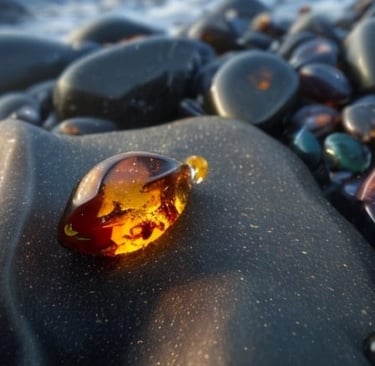
What is Baltic Amber?
Exploring the Origins, Characteristics, and Mystique of Baltic Amber.
3 min read



Baltic amber, often referred to as the "Gold of the North," is a fossilized resin that has been cherished for its beauty and unique properties for thousands of years. Found primarily along the shores of the Baltic Sea, this ancient gemstone is not only a marvel of nature but also a treasure trove of history and culture.
The Origin of Baltic Amber
Baltic amber originated from the resin of prehistoric coniferous trees that grew in the vast forests of northern Europe around 44 million years ago, during the Eocene epoch. These ancient trees, often of the genus Pinites succinifer, produced resin as a defense mechanism against injury or insect infestation. The resin, a sticky and viscous substance, would ooze out of the tree, trapping small insects, plants, and other debris along the way.
Over millions of years, this resin underwent a series of remarkable transformations. Initially, the resin would harden and become insoluble in water, eventually falling to the forest floor. Geological processes, such as sedimentation, pressure, and the absence of oxygen, gradually buried the resin deep underground. Here, it fossilized, transforming into the amber we know today. This process involved polymerization, where the resin's molecular structure changed, making it hard and durable.
The Baltic region, particularly areas in modern-day Lithuania, Latvia, Estonia, Poland, and the Kaliningrad region of Russia, is renowned for producing the highest quality and largest quantities of amber. The unique conditions of this region during the Eocene epoch, such as the presence of vast coniferous forests and the right geological processes, contributed to the formation of this exquisite gemstone.
Characteristics of Baltic Amber
Baltic amber is renowned for its wide range of colors, from the classic golden yellow to rich cognac, deep brown, and even rare shades of green and blue. The color variations are influenced by factors such as the presence of microscopic air bubbles, inclusions, and the degree of oxidation the amber has undergone over millions of years.
Transparency: Baltic amber can range from completely transparent to opaque. Transparent amber is highly valued for its clarity and the visibility of any inclusions it may contain, while opaque amber is prized for its rich, deep colors.
Inclusions: One of the most fascinating aspects of Baltic amber is its inclusions. These can be ancient insects, plant material, and other small organisms that became trapped in the resin millions of years ago. These inclusions provide a unique window into prehistoric ecosystems and are highly valued by both scientists and collectors.
Hardness: On the Mohs scale of hardness, Baltic amber ranks between 2 and 2.5. This relatively low hardness means that amber can be easily scratched or damaged, so it must be handled with care.
Fluorescence: Under ultraviolet light, Baltic amber often exhibits a distinctive blue or green fluorescence, adding to its allure and making it easy to distinguish from synthetic or imitation amber.
Density: Baltic amber has a density of about 1.05 to 1.10 g/cm³, making it relatively light and buoyant. In fact, genuine amber can float in saltwater, a property that has historically aided in its collection along coastal regions.
Uses and Benefits
Baltic amber has been used in various ways throughout history. In ancient times, it was traded as a precious commodity and fashioned into jewelry, amulets, and decorative items. Today, it continues to be highly sought after for its aesthetic appeal and reputed healing properties.
Healing and Spiritual Significance
In holistic medicine, Baltic amber is believed to possess natural healing properties. It contains succinic acid, a compound thought to have anti-inflammatory and pain-relief benefits. Wearing amber jewelry, such as necklaces and bracelets, is said to promote well-being, alleviate pain, and support overall health.
In spiritual practices, particularly within Buddhism, amber holds a special place. It is used in prayer beads (malas) and other ritual objects. The warm, soothing energy of amber is thought to enhance meditation, foster a sense of calm, and connect the wearer to higher spiritual realms.
Caring for Baltic Amber
To maintain the beauty and longevity of Baltic amber, proper care is essential. Amber is a relatively soft and porous gemstone, so it should be kept away from harsh chemicals, extreme temperatures, and prolonged exposure to sunlight. Clean amber pieces gently with a soft cloth and mild soap, avoiding ultrasonic cleaners or steam.
Conclusion
Baltic amber is more than just a gemstone; it is a link to our planet's ancient past and a testament to nature's artistry. Whether appreciated for its scientific value, spiritual significance, or sheer beauty, Baltic amber continues to captivate and inspire people around the world.
Explore the world of Baltic amber and discover the timeless allure of this extraordinary gem. Whether you're a collector, a jewelry enthusiast, or someone seeking a connection to the natural world, Baltic amber offers something truly special.

Information
balticambermala.com All rights reserved.
Follow us at:
